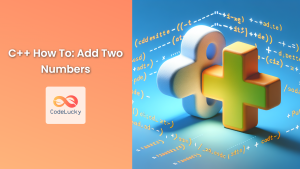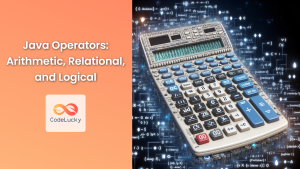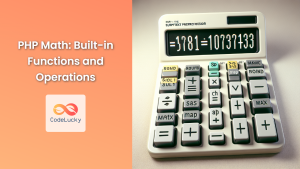C++ provides a robust set of mathematical operations and functions that allow developers to perform complex calculations with ease. Whether you're working on scientific simulations, game development, or financial modeling, understanding these mathematical capabilities is crucial. In this comprehensive guide, we'll explore the various mathematical operations and functions available in C++, complete with practical examples and real-world applications.
Basic Arithmetic Operations
Let's start with the fundamental arithmetic operations in C++. These are the building blocks of more complex mathematical computations.
Addition, Subtraction, Multiplication, and Division
C++ supports the four basic arithmetic operations using the following operators:
- Addition:
+ - Subtraction:
- - Multiplication:
* - Division:
/
Here's a simple example demonstrating these operations:
#include <iostream>
int main() {
int a = 10, b = 5;
std::cout << "Addition: " << a + b << std::endl;
std::cout << "Subtraction: " << a - b << std::endl;
std::cout << "Multiplication: " << a * b << std::endl;
std::cout << "Division: " << a / b << std::endl;
return 0;
}
Output:
Addition: 15
Subtraction: 5
Multiplication: 50
Division: 2
🔍 Note: When performing division with integers, C++ performs integer division, which truncates the decimal part. To get a floating-point result, at least one of the operands should be a floating-point number.
Modulus Operator
The modulus operator % returns the remainder of a division operation. It's particularly useful for tasks like checking if a number is even or odd, or implementing circular buffers.
#include <iostream>
int main() {
int a = 17, b = 5;
std::cout << "17 % 5 = " << a % b << std::endl;
// Checking if a number is even or odd
std::cout << "Is 17 even? " << (a % 2 == 0 ? "Yes" : "No") << std::endl;
return 0;
}
Output:
17 % 5 = 2
Is 17 even? No
Advanced Arithmetic Operations
C++ provides several advanced arithmetic operations through the <cmath> library. Let's explore some of these functions.
Power and Square Root
The pow() function raises a number to a specified power, while sqrt() calculates the square root of a number.
#include <iostream>
#include <cmath>
int main() {
double base = 2.0, exponent = 3.0;
double number = 16.0;
std::cout << base << " raised to the power of " << exponent << " is: " << pow(base, exponent) << std::endl;
std::cout << "The square root of " << number << " is: " << sqrt(number) << std::endl;
return 0;
}
Output:
2 raised to the power of 3 is: 8
The square root of 16 is: 4
Absolute Value and Rounding
C++ offers functions to calculate the absolute value and perform various rounding operations:
abs(): Absolute value (for integers)fabs(): Absolute value (for floating-point numbers)ceil(): Round up to the nearest integerfloor(): Round down to the nearest integerround(): Round to the nearest integer
#include <iostream>
#include <cmath>
int main() {
int intNum = -5;
double doubleNum = -3.7;
std::cout << "Absolute value of " << intNum << " is: " << abs(intNum) << std::endl;
std::cout << "Absolute value of " << doubleNum << " is: " << fabs(doubleNum) << std::endl;
std::cout << "Ceiling of " << doubleNum << " is: " << ceil(doubleNum) << std::endl;
std::cout << "Floor of " << doubleNum << " is: " << floor(doubleNum) << std::endl;
std::cout << "Rounded value of " << doubleNum << " is: " << round(doubleNum) << std::endl;
return 0;
}
Output:
Absolute value of -5 is: 5
Absolute value of -3.7 is: 3.7
Ceiling of -3.7 is: -3
Floor of -3.7 is: -4
Rounded value of -3.7 is: -4
Trigonometric Functions
C++ provides a full suite of trigonometric functions through the <cmath> library. These functions are essential for tasks involving angles, rotations, and periodic phenomena.
Basic Trigonometric Functions
The three primary trigonometric functions are:
sin(): Sinecos(): Cosinetan(): Tangent
Here's an example demonstrating their usage:
#include <iostream>
#include <cmath>
#include <iomanip>
int main() {
double angle = M_PI / 4; // 45 degrees in radians
std::cout << std::fixed << std::setprecision(4);
std::cout << "For angle " << angle << " radians:" << std::endl;
std::cout << "sin: " << sin(angle) << std::endl;
std::cout << "cos: " << cos(angle) << std::endl;
std::cout << "tan: " << tan(angle) << std::endl;
return 0;
}
Output:
For angle 0.7854 radians:
sin: 0.7071
cos: 0.7071
tan: 1.0000
🔍 Note: The M_PI constant is defined in <cmath> and represents the mathematical constant π (pi).
Inverse Trigonometric Functions
C++ also provides inverse trigonometric functions:
asin(): Arcsineacos(): Arccosineatan(): Arctangentatan2(): Arctangent with two parameters
Here's an example:
#include <iostream>
#include <cmath>
#include <iomanip>
int main() {
double value = 0.5;
std::cout << std::fixed << std::setprecision(4);
std::cout << "For value " << value << ":" << std::endl;
std::cout << "asin: " << asin(value) << " radians" << std::endl;
std::cout << "acos: " << acos(value) << " radians" << std::endl;
std::cout << "atan: " << atan(value) << " radians" << std::endl;
// atan2 example
double y = 1.0, x = 1.0;
std::cout << "atan2(" << y << ", " << x << "): " << atan2(y, x) << " radians" << std::endl;
return 0;
}
Output:
For value 0.5000:
asin: 0.5236 radians
acos: 1.0472 radians
atan: 0.4636 radians
atan2(1.0000, 1.0000): 0.7854 radians
Exponential and Logarithmic Functions
Exponential and logarithmic functions are crucial for many scientific and financial calculations. C++ provides several functions for these operations.
Exponential Functions
exp(): Exponential function (e^x)exp2(): 2 raised to the power xexpm1(): e^x – 1
#include <iostream>
#include <cmath>
#include <iomanip>
int main() {
double x = 2.0;
std::cout << std::fixed << std::setprecision(4);
std::cout << "exp(" << x << ") = " << exp(x) << std::endl;
std::cout << "exp2(" << x << ") = " << exp2(x) << std::endl;
std::cout << "expm1(" << x << ") = " << expm1(x) << std::endl;
return 0;
}
Output:
exp(2.0000) = 7.3891
exp2(2.0000) = 4.0000
expm1(2.0000) = 6.3891
Logarithmic Functions
log(): Natural logarithm (base e)log10(): Common logarithm (base 10)log2(): Binary logarithm (base 2)
#include <iostream>
#include <cmath>
#include <iomanip>
int main() {
double x = 100.0;
std::cout << std::fixed << std::setprecision(4);
std::cout << "log(" << x << ") = " << log(x) << std::endl;
std::cout << "log10(" << x << ") = " << log10(x) << std::endl;
std::cout << "log2(" << x << ") = " << log2(x) << std::endl;
return 0;
}
Output:
log(100.0000) = 4.6052
log10(100.0000) = 2.0000
log2(100.0000) = 6.6439
Hyperbolic Functions
Hyperbolic functions are analogous to trigonometric functions but are based on the hyperbola rather than the circle. C++ provides both hyperbolic functions and their inverses.
Basic Hyperbolic Functions
sinh(): Hyperbolic sinecosh(): Hyperbolic cosinetanh(): Hyperbolic tangent
#include <iostream>
#include <cmath>
#include <iomanip>
int main() {
double x = 1.0;
std::cout << std::fixed << std::setprecision(4);
std::cout << "sinh(" << x << ") = " << sinh(x) << std::endl;
std::cout << "cosh(" << x << ") = " << cosh(x) << std::endl;
std::cout << "tanh(" << x << ") = " << tanh(x) << std::endl;
return 0;
}
Output:
sinh(1.0000) = 1.1752
cosh(1.0000) = 1.5431
tanh(1.0000) = 0.7616
Inverse Hyperbolic Functions
asinh(): Inverse hyperbolic sineacosh(): Inverse hyperbolic cosineatanh(): Inverse hyperbolic tangent
#include <iostream>
#include <cmath>
#include <iomanip>
int main() {
double x = 0.5;
std::cout << std::fixed << std::setprecision(4);
std::cout << "asinh(" << x << ") = " << asinh(x) << std::endl;
std::cout << "acosh(" << x + 1 << ") = " << acosh(x + 1) << std::endl; // acosh domain is [1, ∞)
std::cout << "atanh(" << x << ") = " << atanh(x) << std::endl;
return 0;
}
Output:
asinh(0.5000) = 0.4812
acosh(1.5000) = 0.9624
atanh(0.5000) = 0.5493
Error and Gamma Functions
C++ also provides some special mathematical functions that are useful in statistics and scientific computing.
Error Function
The error function erf() and its complement erfc() are used in probability, statistics, and partial differential equations.
#include <iostream>
#include <cmath>
#include <iomanip>
int main() {
double x = 1.0;
std::cout << std::fixed << std::setprecision(4);
std::cout << "erf(" << x << ") = " << erf(x) << std::endl;
std::cout << "erfc(" << x << ") = " << erfc(x) << std::endl;
return 0;
}
Output:
erf(1.0000) = 0.8427
erfc(1.0000) = 0.1573
Gamma Function
The gamma function tgamma() and its natural logarithm lgamma() are extensions of the factorial function to real and complex numbers.
#include <iostream>
#include <cmath>
#include <iomanip>
int main() {
double x = 5.0;
std::cout << std::fixed << std::setprecision(4);
std::cout << "tgamma(" << x << ") = " << tgamma(x) << std::endl;
std::cout << "lgamma(" << x << ") = " << lgamma(x) << std::endl;
return 0;
}
Output:
tgamma(5.0000) = 24.0000
lgamma(5.0000) = 3.1781
Practical Applications
Now that we've covered a wide range of mathematical functions in C++, let's look at some practical applications to demonstrate how these functions can be used in real-world scenarios.
1. Calculating Compound Interest
Here's an example of using the power function to calculate compound interest:
#include <iostream>
#include <cmath>
#include <iomanip>
double compoundInterest(double principal, double rate, int time, int n) {
return principal * pow(1 + (rate / n), n * time);
}
int main() {
double principal = 1000.0; // Initial investment
double rate = 0.05; // 5% annual interest rate
int time = 10; // 10 years
int n = 12; // Compounded monthly
double amount = compoundInterest(principal, rate, time, n);
std::cout << std::fixed << std::setprecision(2);
std::cout << "After " << time << " years, $" << principal << " will grow to $" << amount << std::endl;
return 0;
}
Output:
After 10 years, $1000.00 will grow to $1647.01
2. Calculating Distance Between Two Points
This example uses the Pythagorean theorem and the square root function to calculate the distance between two points in a 2D plane:
#include <iostream>
#include <cmath>
#include <iomanip>
double distance(double x1, double y1, double x2, double y2) {
return sqrt(pow(x2 - x1, 2) + pow(y2 - y1, 2));
}
int main() {
double x1 = 0.0, y1 = 0.0; // First point (0, 0)
double x2 = 3.0, y2 = 4.0; // Second point (3, 4)
double dist = distance(x1, y1, x2, y2);
std::cout << std::fixed << std::setprecision(2);
std::cout << "The distance between (" << x1 << ", " << y1 << ") and ("
<< x2 << ", " << y2 << ") is " << dist << std::endl;
return 0;
}
Output:
The distance between (0.00, 0.00) and (3.00, 4.00) is 5.00
3. Solving Quadratic Equations
This example uses the quadratic formula to solve quadratic equations:
#include <iostream>
#include <cmath>
#include <iomanip>
void solveQuadratic(double a, double b, double c) {
double discriminant = b*b - 4*a*c;
if (discriminant > 0) {
double root1 = (-b + sqrt(discriminant)) / (2*a);
double root2 = (-b - sqrt(discriminant)) / (2*a);
std::cout << "Two real roots: " << root1 << " and " << root2 << std::endl;
} else if (discriminant == 0) {
double root = -b / (2*a);
std::cout << "One real root: " << root << std::endl;
} else {
double realPart = -b / (2*a);
double imaginaryPart = sqrt(-discriminant) / (2*a);
std::cout << "Complex roots: " << realPart << " + " << imaginaryPart << "i and "
<< realPart << " - " << imaginaryPart << "i" << std::endl;
}
}
int main() {
double a = 1, b = 5, c = 6; // Equation: x^2 + 5x + 6 = 0
std::cout << std::fixed << std::setprecision(2);
std::cout << "Solving " << a << "x^2 + " << b << "x + " << c << " = 0" << std::endl;
solveQuadratic(a, b, c);
return 0;
}
Output:
Solving 1.00x^2 + 5.00x + 6.00 = 0
Two real roots: -2.00 and -3.00
4. Calculating Projectile Motion
This example uses trigonometric and logarithmic functions to calculate the trajectory of a projectile:
#include <iostream>
#include <cmath>
#include <iomanip>
const double g = 9.81; // Acceleration due to gravity (m/s^2)
double calculateRange(double velocity, double angle) {
double angleRad = angle * M_PI / 180.0; // Convert angle to radians
return (velocity * velocity * sin(2 * angleRad)) / g;
}
double calculateMaxHeight(double velocity, double angle) {
double angleRad = angle * M_PI / 180.0; // Convert angle to radians
return (velocity * velocity * sin(angleRad) * sin(angleRad)) / (2 * g);
}
double calculateTimeOfFlight(double velocity, double angle) {
double angleRad = angle * M_PI / 180.0; // Convert angle to radians
return (2 * velocity * sin(angleRad)) / g;
}
int main() {
double velocity = 50.0; // Initial velocity in m/s
double angle = 45.0; // Launch angle in degrees
std::cout << std::fixed << std::setprecision(2);
std::cout << "For a projectile launched at " << velocity << " m/s at an angle of " << angle << " degrees:" << std::endl;
std::cout << "Range: " << calculateRange(velocity, angle) << " m" << std::endl;
std::cout << "Maximum height: " << calculateMaxHeight(velocity, angle) << " m" << std::endl;
std::cout << "Time of flight: " << calculateTimeOfFlight(velocity, angle) << " s" << std::endl;
return 0;
}
Output:
For a projectile launched at 50.00 m/s at an angle of 45.00 degrees:
Range: 255.05 m
Maximum height: 63.76 m
Time of flight: 7.20 s
Conclusion
C++ provides a rich set of mathematical operations and functions that enable developers to perform complex calculations efficiently. From basic arithmetic to advanced trigonometric, exponential, and special functions, C++ offers the tools necessary for a wide range of mathematical applications.
In this comprehensive guide, we've explored various mathematical capabilities of C++, including:
- Basic arithmetic operations
- Advanced arithmetic functions like power and square root
- Trigonometric and inverse trigonometric functions
- Exponential and logarithmic functions
- Hyperbolic functions
- Error and gamma functions
We've also demonstrated how these functions can be applied in real-world scenarios, such as financial calculations, geometry, physics, and more.
By mastering these mathematical operations and functions, you'll be well-equipped to tackle complex problems in fields like scientific computing, game development, financial modeling, and data analysis.
Remember to always include the <cmath> header when using these mathematical functions in your C++ programs. Happy coding and calculating! 🧮🚀

















